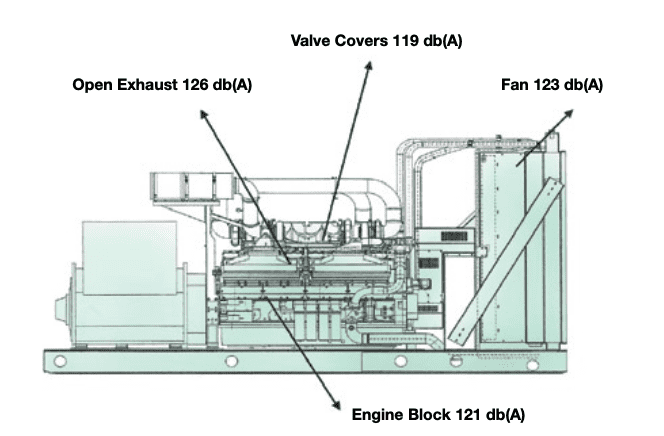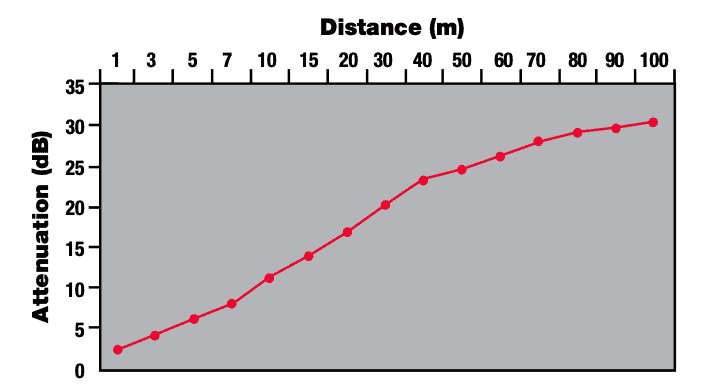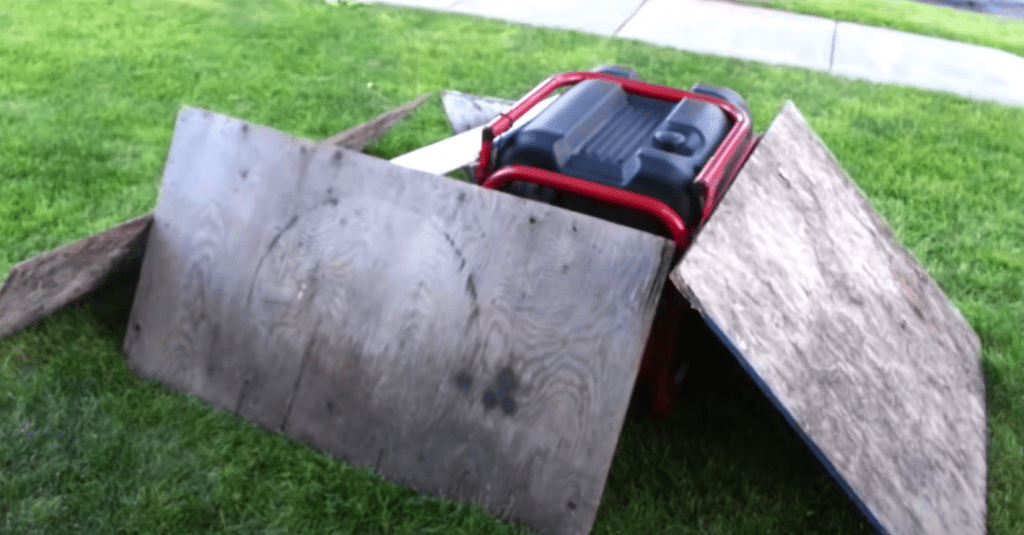Updated June 2022; What’s Changed?
Categorized the guide into 3 parts so you can skip to the most relevant sections: Simple tips, DIY, and ready-made solutions. Added useful data on what parts of the generator actually make noise. After sufficient research, we no longer recommend installing a muffler as our primary method and the guide has been updated to reflect the same.
Picture this:
You’re camping. You find a safe place for parking your RV overnight.
At the campsite, a fellow camper fires up his generator, making a loud rattling noise until midnight.
It gets annoying pretty quickly, right?
Whether you’re looking to reduce your generator noise for camping or your home, this guide details the most efficient ways. This updated edition includes tips from the most knowledgeable: generator manufacturers (like Cummins) and experienced campers.
This guide is divided into three parts:
- The first part covers solutions so simple that even your grandma can understand. Requires no money investment or expertise. If you have already covered the base, skip to the more advanced tips.
- The second part covers DIY options you can do on a budget. You don’t need to be an expert, but some experience with DIY home improvement projects is recommended.
- The third and final part details tips for people who don’t shy from splurging to get the absolute best generator noise-reduction
- Generator Noise Sources: Why are They So Noisy?
- ? Simple Solutions: Under 2 Minutes, No Money or Expertise Required
- 1. Optimal Location: Maximize the Distance From the Generator With an Extension Cord
- 2. Turn the Exhaust Pipes Upward or Away From You Horizontally
- ? DIY Solutions: Requires a Small Budget and Some Expertise to Reduce Generator Noise
- 3. Angle Plywood or Drywall to Deflect Sound Straight Into the Ground
- 4. Acoustic Enclosure: How to Build A DIY Generator Quiet Box
- 5. Is Replacing a Muffler/Silencer on Your Generator Worth it?
- 6. Use Isolation Mounts to Reduce Structural Noise
- 7. Water Bucket Trick: Use Water as a Muffler for Generator
- ?Premium and Highly Efficient Solutions: How to Make Your Generator Quiet as a Cricket
- 8. ZombieBox Noise Reduction Box
- 9. Invest in a Quiet Inverter Generator
- Can a Car Muffler Quiet a Generator?
- How do You Dampen a Generator Vibration?
- How Loud is Too Loud for a Generator?
- Any Tips When Comparing the Noise Levels of Portable Generators?
- Why are Inverter Generators So Quiet?
Generator Noise Sources: Why are They So Noisy?
Before diving into how actually to reduce generator noise, it’s helpful to understand what parts of the generator produce noise so we can treat the type of noise and frequencies accordingly.

The theory isn’t your cup of tea? Feel free to skip to the next section, where we detail actionable tips.
Six major sources produce generator noise include:
- Engine: 100 dB(A) to 110 dB(A), measured at one meter. The combustion process causes this.
- Engine Exhaust: 120 dB(A) to 130 dB(A); A typical exhaust silencer should reduce at least 20 to 40 dB(A)
- Cooling Fan: 95 dB(A) to 105 (A) dB measured at one meter. This is caused by the air moving at high speed across the engine and through the radiator.
- Alternator: 80 dB(A) to 90 dB(A) measured at one meter. It results from cooling air movement by the internal fan and brush friction.
- Induction: 80 dB(A) to 90 dB(A) measured at one meter. The windings’ current fluctuations when load demand changes create this noise.
- Structural Noise: The mechanical vibration of structural paths leads to this noise. Using rubber isolators between the engine, alternator, controls, and other components reduces the amount of vibration that is converted into noise.
Note that these values are of a typical generator set (genset) and are higher than, say, inverter generator or electric generator.

The human ear has such a wide dynamic range that the decibel (dB) scale was devised to express sound levels. The dB scale is logarithmic because the ratio between the softest sound the ear can detect and the loudest sound it can experience without damage is roughly a million to one
Dennis Aaberg, worked in sound and vibration engineering at Cummins for 29 years
Also, the curious one might have spotted that the above sound levels are on the dB(A) scale, not your regular decibel scale (dB). So, what’s the difference between dB and dB(A)?
The dB(L) scale is linear and treats all frequencies equally. However, the human ear doesn’t experience all frequencies similarly. For instance, we’re sensitive to frequencies in 1,000 to 4,000 Hz and lower or higher frequencies are less sensitive.
dB(A) is a frequency-weighted scale that reflects sound pressure levels more accurately how humans actually perceive sound.
Now that you’re a Ph.D. in sound measurement let’s move on to actionable tips on quieting a generator.
? Simple Solutions: Under 2 Minutes, No Money or Expertise Required
We file this under “make sure to have the basics covered” before moving on to more advanced methods. If you already have, skip to the next one.
1. Optimal Location: Maximize the Distance From the Generator With an Extension Cord
The noise levels will decrease approx. 6 dB(A) every time the distance between you and the generator is doubled. Note that this assumes that there are no walls to reflect or amplify the noise. If the property lines are within twice the largest dimensions of the generator, the noise levels might not be predictable.

There are obviously reasonably large limitations to this, though.
Distancing yourself from the generator might not be challenging if you live in a rural place like the King County in Texas, but it isn’t feasible if you live in an urban city with densely-packed homes. Also, if you’ve ever been to a busy campsite like the Adirondack Gateway Campground in NY, you know maximizing the distance is not an option. If the campground offers small camping spots, it’s good practice to be mindful of the neighbors.
If you’re placing a generator in your backyard or home, be aware that there might be local building codes on where you can place your generator.
All the major manufacturers like Honda and Generac should have a decibel rating for every model. It’s worth noting that these “lab tests” measure the generator noise from 7 meters (23 feet) away. Therefore, it might be a good idea to keep your generator at least 23 feet away from your home or campsite if you want to stay in the manufacturer-provided decibel range.
We recommend getting a heavy-duty long extension cord if you have a fairly large backyard or camping site. This will enable you to keep the generator as far as you want. There are a ton of 14 gauge and 16 gauge extension cords. We recommend you get at least 12 gauge with a typical portable generator. This might seem counter-intuitive, but the smaller the gauge number, the more amps/watts it can handle.
It might be worth moving the generator there if you have an outhouse, storage shed, or a detached garage.
2. Turn the Exhaust Pipes Upward or Away From You Horizontally
As discussed above, the engine exhaust is often the highest contributor to generator noise, clocking in at 120 to 130 dB(A) without a typical exhaust silencer.
Generally, most generators have an exhaust pipe facing horizontally. It doesn’t take an expert to figure out that sound waves will travel in the direction it faces.
Try facing the exhaust end of the generator away from your home or campsite. If you’re camping, ensure you don’t face it towards your fellow campers. You can face it towards a forest that absorbs some of the sounds. In some models, it’s possible to re-direct the exhaust pipe vertically, pointing towards the sky.
Note that this only works with airborne sound—the sound from the generator that travels through the air.
After we ensure the basics are in place, let’s move on to more advanced methods. Note that you don’t need to be a DIY expert, but some experience with DIY home improvement projects should certainly help.
? DIY Solutions: Requires a Small Budget and Some Expertise to Reduce Generator Noise
3. Angle Plywood or Drywall to Deflect Sound Straight Into the Ground
For obvious reasons, this tip can only be used on standalone generators, not if the generator is installed into the RV.

There are two sound reduction methods: absorption and deflection. In this method, we’ll use the deflection principle to deflect the sound ways from the generator directly into the ground.
Here’s how:
- Gather 4 to 5 pieces of plywood, 5/8″ drywall, or 1/2″ sheetrock. Most people would have scraps of plywood lying around, so that works great if you’re on a budget. We like sheetrock since it’s fire-resistant. OSB board is another excellent choice since it’s denser than plywood.
- Rest the plywood/drywall/OSB board on the generator and angle them towards the ground. Ensure there’s enough space for airflow. Leave a little spacing at each corner for proper airflow.
- Ensure that you taper them correctly into the ground. If you make a square wall, the sound might bounce from one side to another and find a way out through the gaps. Having grass on the ground helps since it’s a good absorber.
These simple steps should help reduce sound by ~10 dB. Remember, the decibels are a logarithmic scale, which means the noise is cut in half—pretty great for a few minutes of work.
I know what you’re thinking:
“Doesn’t that restrict airflow, causing the motor to run at a higher temperature, eventually shortening the generator life?”
Well, if you follow the process exactly as described—there’s already plenty of room for proper airflow. A typical air-cooled engine requires only a few square inches behind the pull start to pull the cooling air, not the entire 360° airflow. For instance, Honda’s inverter generators are fully enclosed with only a small opening at the front and rear. There might be a minor radiant heat and warm metal frame, but it usually isn’t a cause for concern. If you’re still concerned, consider running temperature checks periodically.
Once you have perfected this set-up, here are some additional tips to improve the noise reduction:
- Line and glue the inside of your plywood/drywall/OSB board with a 1″ thick fireproof sound foam. Alternatively, you can also use flame-retardant Dynamat cat sound-deadening material.
- Fold a thick moving blanket right on top of it.
- In a windy area like Amarillo, TX, you can use a cargo net with spikes into the ground to hold everything in place.
Funnily enough, I shared this “hack” with our fellow campers during our last trip. A gentleman mentioned how they used to do something similar back in his army days. They’d bury a hole deep enough for the Genset with sufficient space around the sides, stack sandbags around the side of the hole to the top, and leave breather holes in the sandbox formation. They put plywood on the top of the sandbags. He exclaimed, “you couldn’t hear the damn generator until you were right up on it!”
So, there you have it: the easiest, inexpensive way to effectively reduce generator noise. Army veteran approved! Just sayin’.
4. Acoustic Enclosure: How to Build A DIY Generator Quiet Box

Building an acoustic enclosure can help reduce noise by up to 10 dB. Here’s step-by-step process to make a DIY generator box:
- Measure the dimensions of your generator. Add an extra 2-3 inches on all sides equally to account for the soundproofing barrier installation and vents. Jot down the measurements.
- Label the measurements on an MDF using a pencil. You could also use regular plywood, but MDF can be more effective. This MDF is what we used and can recommend.
- Use a circular saw, or a table saw to make the cuts. Alternatively, you can have the lumber store do it for you.
- Measure and mark the diameter of the ventilation duct on the fiberboard.
- Make two holes on the opposite side—the first one on the top, more towards one side than the center.
- Cut a piece of MLV based on the measurements of the box. Glue the pieces directly to the inner walls of the box using Green Glue.Consider this Mass Loaded Vinyl from TMS which is 1/8″ thick and comes with an STC rating of 27.
- For additional sound absorption, you can also add rubber foam (vinyl nitrile, neoprene, EPDM, or SBR) padding.
- Assemble the box using nails and screws. Consider adding hinges if you want to make it collapsible and portable for camping trips.
- Make sure the ventilation ducts are installed properly for proper air circulation.
- Your generator box is ready.
We also have a detailed guide on making a DIY soundproof box generator.
5. Is Replacing a Muffler/Silencer on Your Generator Worth it?
If you pop this question about whether you should replace the muffler on your portable generator with an automobile silencer, you’ll likely get conflicting information.
There’s some anecdotal evidence of people being able to reduce the noise by replacing the mufflers.
BCTruck claims they could reduce around ~8dB(A) of sound (from 95 to 85) by adding a cherry bomb silencer to their PowerMate. An old colleague once mentioned that he used one of the two stock mufflers from his Harley Davidson Electra Glide on his 3500w Champion generator with some success.
Unfortunately, like most people, we haven’t been able to replicate this success. And the reason might be pretty straightforward:
Most engine noise comes in two forms: mechanical body noise with rotating parts and exhaust noise. Before investing your time and energy in a muffler, try putting on a thick leather glove and hold an old rag over the muffler outlet to see if it makes any difference. In most cases, it likely won’t. This is because most of the noise is coming straight out of the engine block (Ah, my old Coleman Powermate!)
Also, using something as restrictive as a stock car or motorcycle muffler can potentially change the jetting on your carb and burn up valves quickly. You can also lose power.
While a muffler might not be a good choice for portable or freestanding generators, it can work well for generators installed inside an RV. This is because most of the “other” noise doesn’t escape from the RV already.
Our current stance is that a muffler won’t significantly reduce noise on a portable generator. However, we still include it in this guide since it tends to work for a select few. If you have first-hand experience in doing so, please comment on your detailed expertise below. Open to changing our opinion with the proper evidence.
Until then, we recommend more efficient methods such as sound deflectors.
Moving on:
If you’re looking to reduce noise on a home standby (also called stationary or whole-house generators), you have plenty of options.
Generally, most standalone generators come with an exhaust silencer/muffler and reduce at least 20 to 40 dB(A). The two main types of mufflers are chamber and spiral. Chamber-style mufflers are more effective, while spiral is more compact and substantially reduces noise. They are usually made of cold-rolled or stainless steel. We prefer the stainless steel ones for outdoors since it doesn’t rust.
Silencers for home generators come in various grades, depending on how much noise they can dampen:
- Industrial: 12 to 18 dB
- Residential: 20 to 25 dB
- Critical: 25 to 32 dB
- Hospital Plus: 35 to 50 dB
There are three types of silencers when categorized by how they work:
- Reactive: Use three chambers to trap noise; work great for low to mid-range frequencies
- Absorptive: Use fiberglass insulation; it works great for high-frequencies
- Combination: Use a combination of reactive and absorptive to muffle wide variety of noises
6. Use Isolation Mounts to Reduce Structural Noise
Vibrating equipment creates noise. The genset’s vibrations are transferred to the building structure with connection points like fuel lines, coolant piping, skid anchors, and wiring conduit.
Hardly a surprise, right?
Stucture-borne noise happens when a unit is rigidly connected to a structural base like a concrete slab. When the equipment vibrates, the structure vibrates, thus creating a sound.
—Bonnie Schnitta, Owner of SoundSense, an acoustic consulting firm and manufacturer of sound control products
Using rubber isolators between the engine, alternator, controls, and other components reduces the amount of vibration that is converted into noise. You can mount it on spring-type vibration isolators to reduce the noise transmitted through the floor.
Avoid placing the generator on a wood, asphalt, or concrete base as hard surfaces amplify sound. You can DIY rubber feet or anti-vibration mat/pads to reduce structural and mechanical noise. If you’re camping, likely, the generator is already resting on grass—which is actually great since it absorbs some of the noise.
If you’re installing in your home: After finalizing the location, we recommend you approve it by your local code authority and obtain a building permit. After all, you don’t want to waste time and money if it doesn’t meet local codes. Additionally, a permit ensures that an insurance company will honor the policy in case of fire or other unforeseen damages.
Some manufacturers include a suitable base for the generator. If it doesn’t, here’s how to make a good pad easily:
- Remove the sod/turf and make a rectangular shaped hole as required and six inches deep
- Add and compact a four-inch layer of damp sand
- Enclose the gravel using a frame made of cedar or pressure-treated lumber
- Level the frame, fill it with pea gravel
Voila, you’re ready to rest your generator on it!
7. Water Bucket Trick: Use Water as a Muffler for Generator
We once saw a guy at a local lake using a portable generator on his swim platform. And man, you could barely hear it running from a distance.
He had welded a pipe onto his muffler, so the pipe was a couple of inches below the water surface.
But you might be wondering:
“Isn’t the back pressure in the exhaust bad for the generator?”
It turns out, submersing two inches in the water doesn’t create a lot of back pressure. There are far worse things you can do, like, overloading it.
Here’s how you can use water a to dampen or muffle the sound:
- Begin by ensuring the generator is placed higher than the water. This is important to not allow the backflow of water into your generator’s exhaust pipe. If you want to be extra careful, you can also poke a few small holes in the hose.
- Clamp the hose to the exhaust pipe.
- Place the other end of the hose into a 5-gallon bucket of water.
- When turned on, the sound waves should travel from the exhaust to the water, thus dampening them.
One obvious limitation of this method is that it only works to reduce noise from the exhaust, not the actual engine unit. Therefore, it’s best to use it with other ways that reduce engine noise, like plywood sound deflectors and building an acoustic enclosure.
?Premium and Highly Efficient Solutions: How to Make Your Generator Quiet as a Cricket
8. ZombieBox Noise Reduction Box
If you don’t want to go the DIY route and are willing to splurge, consider getting a ZombieBox. It’s a portable and weatherproof noise-reducing enclosure for standby or portable generators. It can reduce noise by up to 18 dB. For reference, that is roughly 4x quieter.
We haven’t had the opportunity to test this, but the company has helpful videos demonstrating a noise reduction from 84 dBA to 64 dBA.
ZombieBox claims its boxes are used by Federal and State agencies and the military. You can check ZombieBox here.
9. Invest in a Quiet Inverter Generator
We know this sounds like an extreme measure, but if you’re in the market looking for a new generator or replacing your older one, these tips might be helpful.
The first thing:
As a general rule, the more powerful the generator, the louder it will be. Therefore, consider your energy consumption needs to choose a generator with the appropriate power output.
A 2,000-watt generator should be sufficient for most RVers if you aren’t planning to run a microwave, air conditioner, or water heater. If you are, a 3,500-watt generator should be sufficient.
Secondly, consider getting an inverter generator if you’re in the market for a new portable generator. It electronically throttles the engine to meet demand instead of running at full power all the time.
The result?
Less fuel consumption. Lower emissions. And they’re generally very quiet since they’re inside an insulated casing. Our top recommendation is the Honda EU2200ITAG 2,200-Watt Generator which is an absolute powerhouse for RVers and clocking in at just 48 to 57 decibels.
Can a Car Muffler Quiet a Generator?
We recommend you don’t fit an automobile muffler on a generator because most generator noise comes through the engine block, not the exhaust. Before investing your time and energy in a muffler, try putting on a thick leather glove and hold an old rag over the muffler outlet to see if it makes any difference. Instead, consider building a quiet generator box or use the plywood sound deflector method.
How do You Dampen a Generator Vibration?
You can use rubber isolation mounts, DIY rubber legs, or an anti-vibration mat to dampen a generator vibration and reduce structural noise.
How Loud is Too Loud for a Generator?
Ideally, generators shouldn’t be louder than 60dB (A) measure at 50 feet, according to the National Park Service.
Any Tips When Comparing the Noise Levels of Portable Generators?
It’s critical to understand how manufacturers measure noise for a fair comparison. Most manufacturers measure noise from about 7 meters (23 feet) What this essentially means is the decibels you see on the label are how loud you’ll hear it from 23 feet away.
We recommend you begin by finding your city or building’s local noise ordinances. NoiseFree is an American NGO that frequently lists the noise ordinances for major cities.
Lastly, ensure you’re comparing the noise levels of generators with equal power outputs.
Depending on the label, you might see a metric called sound pressure level (LwA). This is a European standard for noise.
Why are Inverter Generators So Quiet?
Inverter generators are quieter than other non-inverter generators because of their design and the latest technology used for their operations. They reduce mechanical noise by generating power in three stages.
Firstly, AC is produced, then it is converted to DC and then again back to AC. By doing so it can alternate the speed of the engine accordingly and create minimal noise.
Besides this, all modern generators are equipped with the latest technology and sound-attenuating materials which further baffles noise.
